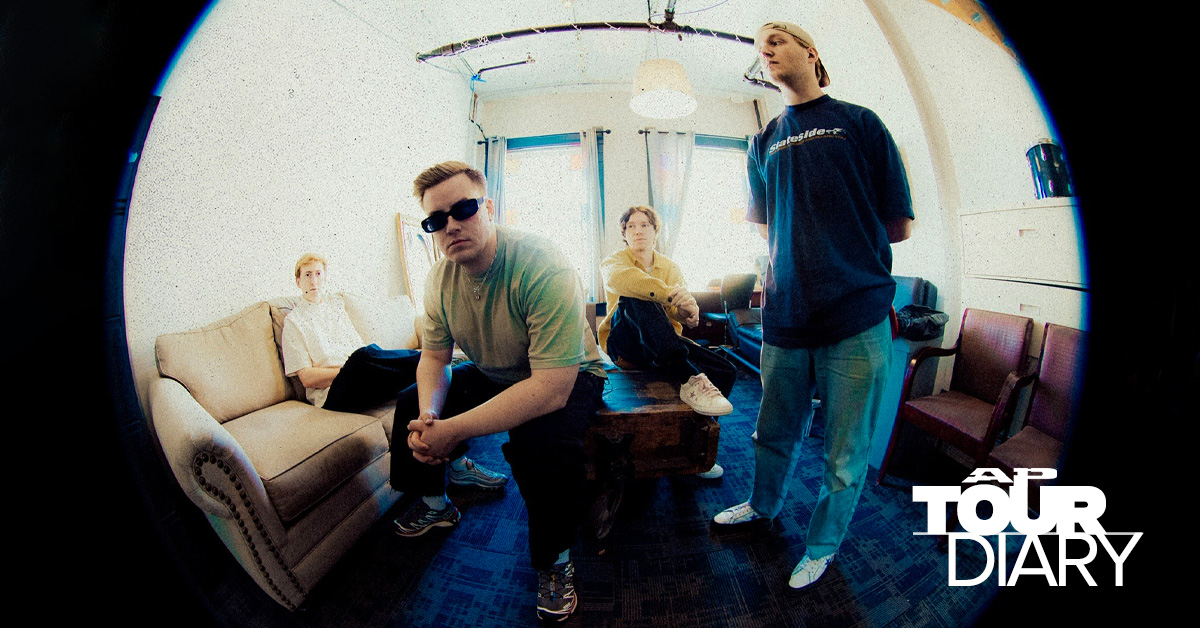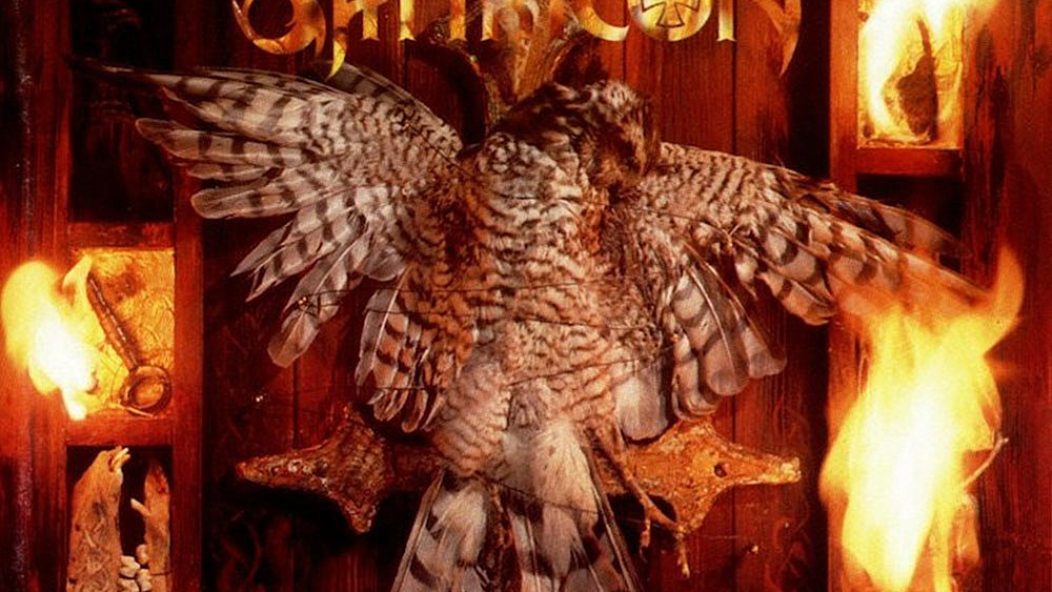
Opening the Gate to Immortality: 25 Years of Satyricon’s "Nemesis Divina"
Satyricon just finally put their first two albums back out on vinyl (grab exclusive variants of each in our shop), but today Joe takes a look back at their third, which turns a quarter of a century old this week.
…
Black metal existed before the Norwegian scene began, and it certainly has flourished internationally since the heyday of infamy in Norway in ways that many never expected. Yet, what can never be denied is the deep impact the Norwegian scene had on black metal and occasionally still does through its old guard and younger inheritors. As has been documented in countless places, Mayhem’s mastermind Euronymous, real name Øystein Aarseth, helped nurture the Norwegian black metal scene, being sometimes highly open to creative experimentation and at others close-fisted in control. After his death in the late summer of 1993, it was an open question as to how the scene locally, and in part globally, would proceed. Would the next few years see the bands energized by his vision and influence drift away, or would the genre continue on to reach heights Euronymous could have only dreamed of—or even feared?
The two decades and more since that time has proven the latter, in hindsight, as Norwegian black metal (and the global scene as well) only exploded into larger and more dynamic approaches. One band that played a pivotal part was Satyricon, forged by the combined talents of songwriter/frontman Sigurd “Satyr” Wongraven and lauded drummer Kjetil-Vidar “Frost” Haraldstad. Neither were original members of the band, but they soon found themselves the only ones left after multiple departures. Subsequently, they would form the core duo propelling the band to this day—not too different than fellow countrymen Darkthrone, save for having a far more gusto approach to live performances than the latter. 1994 saw Satyricon deliver a pair of medieval (in atmosphere) Norwegian folk music-influenced black metal albums, with Dark Medieval Times and The Shadowthrone. These two records made waves right alongside, if perhaps a bit out of focus, the many legendary albums released from the scene that year from the likes of Mayhem, Emperor, and Enslaved. Two years later, and just yesterday celebrating its 25th anniversary, Satyricon released their third album Nemesis Divina, a nearly instant classic that threw the band into the lead pack of the scene. It was also an album that would serve as an era-ending marker, as the band would in no short time further expand its horizons and self limitations.
…
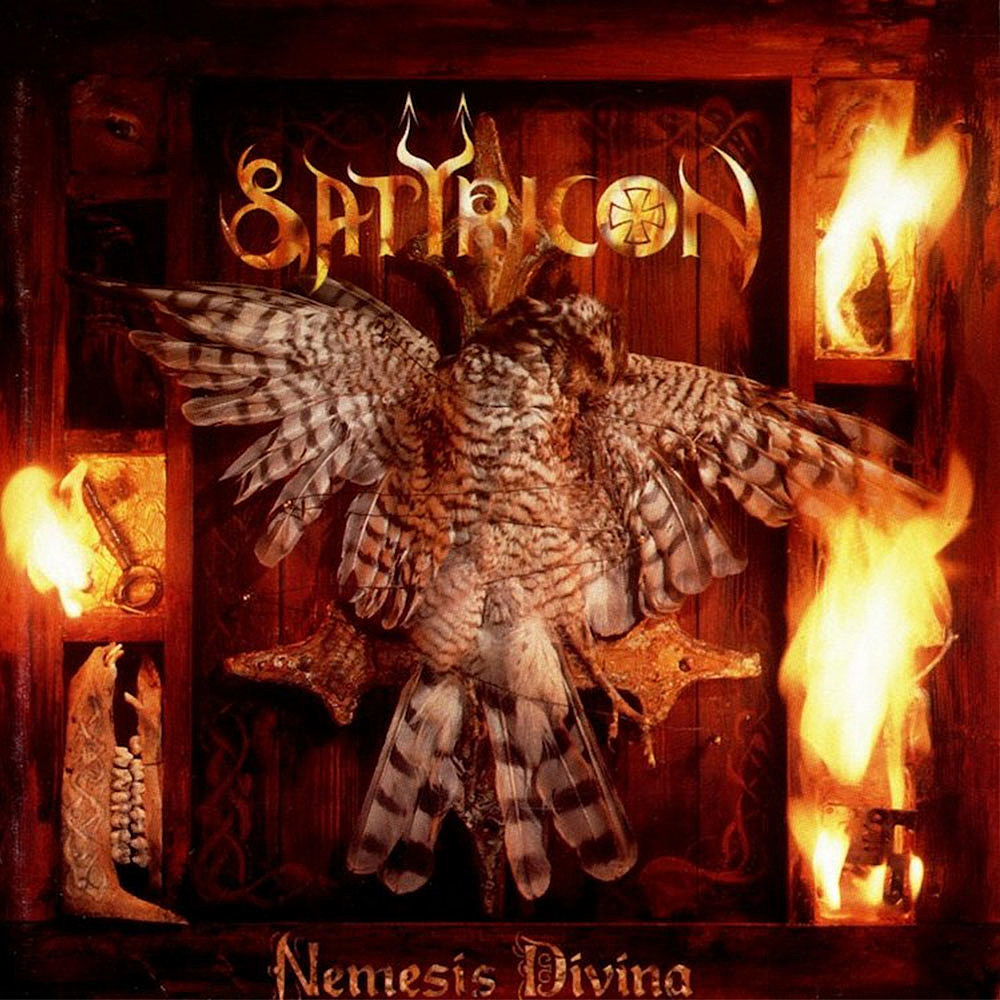
…
Before diving into the music of Nemesis Divina, it would be remiss to not mention how bold and forward-thinking the album’s artwork proved to be. At that point, most prototypical black metal album covers, especially in the Norwegian scene, were rough DIY black and white photographs, similarly stark sketch drawings, or shadowed images with dark toned color: something exemplified not only broadly across the genre but clearly enough in Satyricon’s own first two albums. Nemesis Divina’s cover, designed by Halvor Bodin and Stein Løken, is a well-lit wooden shadow box with a pinned bird of prey atop an inverted and rusted crucifix. Outward from the center image are trinkets like bones, keys, and other pieces partially engulfed in flames billowing out from the wood with the same golden flames illuminating the band’s logo.
In an interview, Frost recalled the artists behind the cover design creating an art installation based on themes Satyr conveyed from the album which they then set on fire and photographed. “I think it was a brilliant solution of (sic) the task, which was to create an idiosyncratic piece of artwork with references to the album and with very particular aesthetic qualities,” said Frost in the interview. “It truly gave the album a visual identity.” This quality can be seen in the aesthetics of later black metal, whether consciously or not, with yellow/orange hues like Dawn’s Slaughtersun (Crown of the Triarchy) or Mayhem’s own image of avian sacrifice on Grand Declaration of War.
Upon listening to the album, one would certainly agree with Frost’s assessment of a successful visualization, as Satyricon’s previously established identity is blown up into higher-fidelity recording and a real streak of fiery aggression burning throughout the instrumentation. The previous albums’ lone acoustic guitar passages are abandoned, while the keyboards are arranged very much in accompaniment to the guitar riffs rather than taking sole focus. A Norwegian folk music influence can still be felt, a trait that regardless of other changes has been a constant throughout the band’s career. In particular, it’s used as thematic breaks from the aggressive fury. This can be heard most prominently on the two main riffs in the second half of “Forhekset” and the keyboard passage playing over the hypnotic tremolo riff at the end of “Du som hater Gud.” The aforementioned higher definition in recording allows the instruments to all be heard in exquisite clarity rather than cacophony, permitting listeners to readily appreciate the talents behind the compositions. This particularly benefits Frost: drumming isn’t always intuitively appreciated in black metal, but here the listener can follow every blast, crash, and kick he delivers at varied paces in wonderful detail.
…
…
The album’s aggression is present right at the beginning in what might be one of the most powerful black metal album openers: “The Dawn of a New Age.” After a brief clanging of chords and a spooky keyboard passage, Satyr shouts from the depth of hell, “This is Armageddon!” Seriously, how much more metal can you get? Well, the song steamrolls forward as Satyr lyrically reinterprets passages from the Book of Revelations detailing the arrival of the final horseman of the apocalypse, Death. The pace keeps up until a mid-tempo riff seemingly slows down time, leading into a break for a clean electric guitar passage that rings out like the still air after a battle; it’s then violated by a new assault of infernal forces accompanied by spectral narration thanks to the guest work of former bandmate Samoth’s ex-wife Nebelhexë (Andrea Meyer Haugen). Yeah, pretty damn metal.
Speaking of collaborators and guests, during the recording and subsequent touring for Nemesis Divina none other than Ted “Nocturno Culto” Skjellum of the mighty Darkthrone joined on rhythm guitar, under the (uniquely devised for the group) pseudonym of Kveldulv. In Decibel Magazine’s Hall of Fame feature for Nemesis Divina Skjellum himself describes a perfect set of temporary circumstances where visiting his girlfriend at the time in Oslo became a good excuse to work with Satyricon. In his words, “I missed playing guitar and having the ‘band’ feeling,” which makes sense given Darkthrone had recently given up on playing live around then, and further: Fenriz had taken all the guitar duties on the previous two Darkthrone albums at that point. Fenriz also collaborated on Satyricon’s developing masterpiece, lending his lyrical penship to the track “Du som hater Gud.”
At one point, Ihsahn of Emperor contributed some keyboard playing for the early rehearsals of Nemesis Divina, though Emperor reforming called his attention away and eventually the keyboard role fell on the shoulders of Geir Bratland, a member of EBM—electric body music—group Apoptygma Berzerk who has subsequently played in groups like Dimmu Borgir, The Kovenant, God Seed, and even live for Emperor in 2018. In an interview for Metal Hammer/Louder Frost noted the collaboration in the black metal scene back then made sense, saying, “It was a pretty small environment that we existed in back then. We all felt like competitors, but in other ways like colleagues and friends – people with a common interest in something that was very marginal and particular.”
…
…
Regardless of the collaboration or the many highlights of composition found throughout the album, the near indisputable crown jewel is “Mother North,” a track that has lived on to perhaps be the most recognizable song in Satyricon’s entire career. A mini-epic of a track at six-and-a-half minutes with varied paces, brooding atmospheres, and infectious melodies that would prove to elicit crowd chanting at live venues across the world. It’s interesting to note that in many outlets both Satyr and Frost have commented that the latter’s desire to pummel his kit had to be toned down to allow breathing room for the rest of the pieces of the composition. This annoyed Frost at the time, but he’s since admitted it was the right move for the song. It can be seen as a positive for Satyricon’s career that Satyr stuck to his vision for the song, as it’s become one of the earliest cases of a black metal “hit single”: it’s been a highlight for most Satyricon concerts, where during one of the most melodic and slow to mid paced riffs of the song the crowd often begins chanting along. Even if one has never had the pleasure to participate in that moment live themselves, scenes like Satyricon playing live at Wacken or having a full choir accompanying them during the Live at the Opera recording instantly raise goosebumps in those moments. In the aforementioned piece published by Metal Hammer, Satyr comments, “[W]e play ‘Mother North’ as much as any other song, but although I don’t always enjoy rehearsing it, when we play live I feel like I can perceive it through the eyes and the ears of members of the crowd and it makes me think of things and feelings that I would never otherwise be able to access. Not every band has a song that defines an era, but ‘Mother North’ certainly does that.”
One thing that helped “Mother North” become such a hit was its music video, perhaps one of the first, or at least certainly earliest, examples of a black metal music video. It’s more of an atmospheric dream than a linear story, but it does a fine job of not only exhibiting the themes Satyr had in mind for the song, mainly a romanticism for Norway itself, but a full in-the-flesh exhibit of many key elements of the whole Norwegian black metal scene. A swung axe crashing down on a cross coincides with the opening of the song followed by images of the band in full corpse paint, studs and spikes, fire breathing, rituals performed in a flamed circle, thick fog, a full moon, deep forests, overflowing blood often in vampiric scenes, and model Monica Bråten’s (at times fully nude) trance like stare straight into the camera. In an interview, Frost recounted the making of the video that, “I remember that many of the scenes were incredibly hard to do, as they were shot outdoors in the winter, and that bringing all the gear and doing takes over and over again until they were right meant that we would be out in the cold for an entire night. I also did a fire breathing scene in the beginning of the session, and as it was windy, I got totally soaked in gasoline before I was done doing that countless number of takes. Eventually I became so cold that I vomited on the way back from the location. I didn’t care much about that, though–my only concern was whether we would manage to make the video visually striking enough.”
Satyricon would change rather quickly after the Nemesis Divina era. Feeling that others were starting to copy what they’d already accomplished, they released 1999’s Rebel Extravaganza which abandoned a great deal of their previous imagery and tone for more industrial and urban atmospheres. They then followed in 2002 with Volcano, an album that helped form the foundation for a great deal of the black n’ roll subgenre, which they’ve in various ways continued and expanded upon since then. Throughout their career, the legacy and success of Nemesis Divina has continued to help propel them forward: in 2016 the band, often seen as hesitant to feel nostalgic about their past, toured the whole album front to back, a lovely tribute to newer fans who weren’t there two decades prior and the old ones who stuck with them through their evolution. Five years since then, the album is now a quarter-century old and it continues to be regarded as a well-aged classic album still delighting fans the world over. In the words of its highlight song: ‘Mother North — united we stand, together we walk.”
…
![]()
…
Nemesis Divina released April 22nd, 1996 via Moonfog Productions.
You can pick up exclusive variants of The Shadowthrone and Dark Medieval Times in our webshop.
![]()





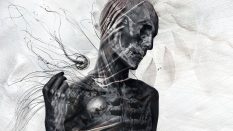

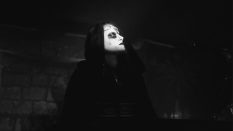
![Bad Omens announce new album CONCRETE JUNGLE [THE OST]](https://www.altpress.com/wp-content/uploads/2024/04/17/BadOmens-CROP_2024_JW_0619_Final_V1.jpg)

